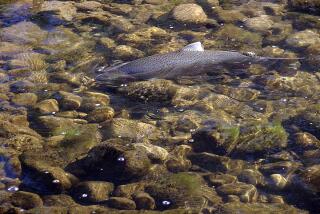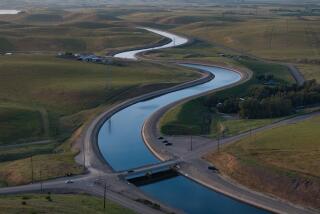Removal of 4 Klamath dams would lift salmon count, studies find
Removing four hydroelectric dams and restoring habitat on Northern California’s Klamath River would significantly boost the watershed’s chinook salmon population and the commercial salmon catch, according to several dozen federal reports released Wednesday.
The U.S. Interior Department will rely on the documents to decide whether the dams should be torn down. Removal of the structures would open upper portions of the Klamath to struggling salmon populations that have been blocked from historic spawning grounds for nearly a century.
“The reports issued today represent the most complete body of information to date on the science involved in Klamath River dam removal and the project’s potential for job creation,” said Interior Secretary Ken Salazar.
The dam decommissioning is part of a pact reached last year by farmers, environmentalists and tribes who have fought for years over the river, which once had one of the nation’s most abundant salmon runs.
Under the agreements, PacifiCorp utility customers in Oregon and Northern California, along with the state of California, would pay for the removal. The federal government would fund up to $1-billion worth of water management, habitat restoration and monitoring programs.
Environmental reviews and a number of separate technical studies concluded the project would open more than 400 miles of upstream habitat for steelhead. It would also increase the annual median production of adult chinook in the Klamath basin by 81% and the median commercial and sport ocean catch of chinook by 46%.
Combined with restoration efforts, the removal would improve water quality, reduce fish disease and create more than 5,000 jobs, according to the reports, which estimated the cost of dam demolition at $291.6 million.
The project would also eliminate hydroelectric generation that would have to be replaced by PacifiCorp, a subsidiary of billionaire Warren Buffett’s Berkshire Hathaway Inc. The utility agreed to the decommissioning in the face of expensive re-licensing requirements for the dams, which are spread across 65 miles of the Klamath near the Oregon border. Currently, the four dams generate enough power to supply 70,000 homes.
The draft environmental impact statement acknowledges that even when the dams are gone, fall-run chinook would have to be trapped and trucked around a stretch of the river that would continue to suffer from warm temperatures and low oxygen levels during part of the year.
An analysis by an independent science panel earlier this year was more skeptical of the project’s outcome. While the scientists agreed the effort could increase the salmon population, they said the plans failed to adequately address a number of serious water-quality problems that would hinder salmon recovery.
More to Read
Start your day right
Sign up for Essential California for news, features and recommendations from the L.A. Times and beyond in your inbox six days a week.
You may occasionally receive promotional content from the Los Angeles Times.






